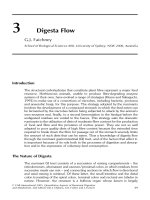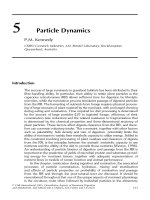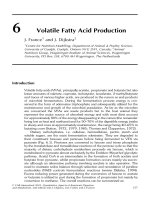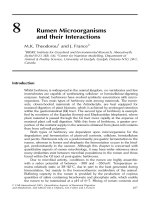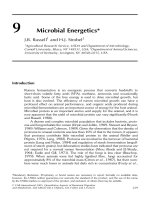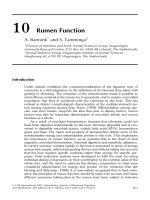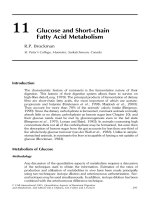Quantitative aspects of ruminant digestion and metabolism - Phần 7
Bạn đang xem bản rút gọn của tài liệu. Xem và tải ngay bản đầy đủ của tài liệu tại đây (279.54 KB, 34 trang )
9
Microbial Energetics*
J.B. Russell
1
and H.J. Strobel
2
1
Agricultural Research Service, USDA and Department of Microbiology,
Cornell University, Ithaca, NY 148531, USA;
2
Department of Animal Sciences,
University of Kentucky, Lexington, KY 40546-0215, USA
Introduction
Rumen fermentation is an exergonic process that converts feedstuffs to
short-chain volatile fatty acids (VFA), methane, ammonia and occasionally
lactic acid. Some of the free energy is used to drive microbial growth, but
heat is also evolved. The efficiency of rumen microbial growth can have a
profound effect on animal performance, and organic acids produced during
microbial fermentations are an important source of energy for the host animal.
Microbial protein is an important amino acid supply for the animal, and it is
now apparent that the yield of microbial protein can vary significantly (Nocek
and Russell, 1988).
A diverse and complex microbial population that includes bacteria, proto-
zoa and fungi inhabits the rumen (Orpin and Joblin, 1989; Stewart and Bryant,
1989; Williams and Coleman, 1989). Given the observation that the density of
protozoa in omasal contents was less than 10% of that in the rumen, it appears
that protozoa contribute little microbial protein to the animal (Weller and
Pilgrim, 1974; Leng, 1982). Protozoa are involved in the turnover of bacterial
protein (Leng and Nolan, 1984) and regulation of starch fermentation (engulf-
ment of starch grains), but defaunation studies have indicated that protozoa are
not required for a normal rumen fermentation (Abou Akada and El-Shazly,
1964; Eadie and Gill, 1971). The role of the fungi is less clear (Bauchop,
1979). When animals were fed highly lignified fibre, fungi accounted for
approximately 8% of the microbial mass (Citron et al., 1987), but their num-
bers were much lower in animals fed diets rich in concentrates (Fonty et al.,
*Mandatory disclaimer: Proprietary or brand names are necessary to report factually on available data;
however, the USDA neither guarantees nor warrants the standard of the product, and the use of the name
by the USDA implies no approval of the product, and exclusion of others that may be suitable.
ß CAB International 2005. Quantitative Aspects of Ruminant Digestion
and Metabolism, 2nd edition (eds J. Dijkstra, J.M. Forbes and J. France)
229
1987). The bacteria are the dominant microbial group in the rumen, and they
are clearly essential.
With the evolution of molecular techniques, it has become apparent that
bacterial diversity in the rumen is much greater than previously thought, and it
is likewise evident that the rumen has a large population of non-culturable
bacteria (Whitford et al., 1998; Tajima et al., 1999). None the less, individual
species performing all of the major metabolic transformations observed in the
rumen have been isolated, and the activities of these organisms serve as a
model of ruminal fermentation (Hungate, 1966; Prins, 1977). The fermenta-
tion pathways of these organisms are fairly well understood, but there has been
less information regarding the energetics of growth (Hespell and Bryant,
1979).
ATP Formation
The absence of oxygen and production of reducing agents (e.g. sulphide) in the
rumen creates a highly reduced environment (E
h
¼À250 to À450 mV) that
is suitable for the growth of strictly anaerobic bacteria (Clarke, 1977). In
virtually all cases, strict anaerobes outnumber facultative anaerobes and
aerobes by a factor of at least 10,000 to 1. Because oxygen is not available
as an electron acceptor, other means of oxidation must be employed and
these oxidations must be closely coupled to reduction reactions. Anaerobic
oxidations are, by their very nature, incomplete, but ruminal bacteria have
evolved very efficient mechanisms of energy conservation. They often produce
as many cells from glucose as Escherichia coli grown aerobically, even though
the free energy change is as much as sevenfold lower (Russell and Wallace,
1989).
Carbohydrates are the primary energy source for microbial growth in the
rumen, and the majority of ruminal bacteria ferment carbohydrates (Hungate,
1966). Some carbohydrate-fermenting ruminal bacteria also ferment amino
acids, but most of them are unable to utilize amino acids or peptides as a sole
energy source (Bladen et al., 1961). The rumen also contains specialized
obligate amino acid-fermenting bacteria, and these bacteria appear to produce
a large fraction of the ammonia in cattle-fed forages (Russell et al., 1988; Chen
and Russell, 1989; Attwood et al., 1998). Although some ruminal bacteria are
able to hydrogenate fats, lipid metabolism alone does not support microbial
growth in the rumen (MacZulak et al., 1981).
Most carbohydrate entering the rumen is composed of hexose sugars
(Wolin, 1960), and
14
C labelling studies indicated that the Embden–Meyerhof
pathway was the major route of glucose fermentation by ruminal microorgan-
isms (Baldwin et al., 1963). This pathway splits a carbon–carbon bond (fruc-
tose 1,6 bisphosphate), but little energy is derived from this cleavage. During
homolactic fermentation, glucose, a molecule of neutral and uniform oxida-
tion–reduction state, is converted to lactate, which has a highly reduced methyl
group and a highly oxidized carboxyl group. Most of the free energy change is
derived from this simultaneous oxidation and reduction.
230 J.B. Russell and H.J. Strobel
The role of phosphate esters in fermentation was recognized by Harden
and Young (1906), but it was not until the early 1940s that the significance of
phosphate esters was more fully appreciated (Lipmann, 1941). For many
years, biochemists focused on the anhydride structure of ATP to describe the
‘high energy’ nature of the compound. However, as Nicholls and Ferguson
(1992) noted, the mass action ratio and the extent to which the reaction is
displaced from equilibrium actually determine the free energy change of ATP
hydrolysis. Since the mass action ratio in living cells is as much as ten orders of
magnitude out of equilibrium, ATP serves as an effective means by which to
transfer metabolic energy.
ATP can arise from enzymatic reactions, which give rise to phosphorylated
intermediates (e.g. 1,3 bisphosphoglycerate, phosphoenolpyruvate, acetyl
phosphate and butyryl phosphate) and kinase reactions (e.g. phosphoglycerate
kinase, pyruvate kinase, acetate kinase and butyrate kinase), which transfer a
phosphate group to ADP. In anaerobic protozoa, acetyl CoA lyase is directly
coupled to ATP formation (Coleman, 1980). These reactions are collectively
known as substrate level phosphorylation.
Previously, it was assumed that substrate level phosphorylation was the
only mechanism of energy conservation in anaerobic bacteria. However,
White et al. (1962) showed that the ruminal bacterium, Prevotella (Bacter-
oides) ruminicola, had cytochromes. The observation that many Bacteroides
strains required hemin, and the influence of hemin on growth yield and
succinate production suggested that fumarate reduction might be linked to
ATP formation (Macy et al., 1975). In fact, coupling of fumarate reduction
and ATP synthesis was demonstrated in the ruminal bacterium Wolinella
succinogenes (Kroger and Winkler, 1981). The acrylyl CoA reductase of
Megasphaera elsdenii also involves electron transfer, but there is as yet no
evidence that this reaction is linked to ATP formation (Brockman and Wood,
1975).
Pure cultures of ruminal bacteria often produce reduced products (e.g.
ethanol and lactate) and sacrifice ATP for reducing equivalent disposal. How-
ever, methanogens keep the partial pressure of hydrogen low in vivo, and
under these conditions hydrogen production provides an alternative means of
oxidation (Wolin and Miller, 1989). Such interspecies hydrogen transfer and
methanogenesis allow saccharolytic bacteria to produce acetate and increase
their ATP production.
Some ruminal bacteria vary their fermentation end-products as a function
of growth rate and this influences ATP production. Selenomonas ruminan-
tium (Russell, 1986) and Streptococcus bovis (Russell and Baldwin, 1979)
switch from VFA production to homolactic fermentation at rapid growth rates,
even though ATP production per hexose apparently decreases (3 or 4 to 2
ATP per hexose). Such a change might seem detrimental, but as Hungate
(1966) pointed out, ATP per unit of time is a more critical factor than ATP
per glucose. Since S. bovis and S. ruminantium can ferment glucose at a
faster rate when lactate is the end-product, ATP per time increases even
though ATP per glucose decreases.
Microbial Energetics 231
Ion Gradients
ATP formation is the primary energy transducing mechanism for fueling
biosynthesis, but transmembrane ion gradients are also critical components
of bacterial energy transduction. According to the chemiosmotic theory of
Mitchell (1961), bacteria translocate protons across the cell membrane to
establish a chemical gradient of protons (DpH) and a charge gradient (DC).
Electron transport systems (e.g. cytochrome-linked fumarate reductase) can
establish proton gradients, but many anaerobes must rely almost exclusively
on membrane-bound proton ATPases to expel protons from the cell interior. In
certain streptococci, lactate efflux can be coupled to electrogenic proton efflux
(Michels et al., 1979), but such mechanisms have not been demonstrated in
ruminal bacteria.
Although proton gradients are the major means of coupling energy to
membrane function, sodium gradients play a significant role in the bioenerget-
ics of many bacteria (Maloy, 1990). Most bacteria maintain low intracellular
concentrations of sodium, and in E. coli these gradients are created by a
sodium/proton antiporter, which interconverts the chemical gradient of pro-
tons into a chemical gradient of sodium (West and Mitchell, 1974). The rumen
is a sodium-rich environment ($100 mM), and ruminal organisms take advan-
tage by employing sodium-dependent transport systems (see below). Relatively
little work has been done on sodium-expulsion systems in ruminal bacteria, but
there is evidence that S. bovis has an ATPase which pumps sodium as well as
one that pumps protons (Strobel and Russell, 1989).
Decarboxylation reactions are associated with a decrease in free energy,
but decarboxylation is not typically coupled directly to synthesis of ATP (Buckel,
2001). However, energy in the form of an electrochemical ion gradient can
be used to drive ATP synthesis. For instance, the ruminal organism Oxalobac-
ter formigenes transports oxalic acid across the cell membrane with subse-
quent decarboxylation to formate and carbon dioxide (Kuhner et al., 1996).
This decarboxylation consumes an intracellular proton thus generating a pro-
ton gradient. In addition, substrate uptake involves an antiport exchange with
one of the products, formate. This exchange is electrogenic (net accumulation
of negative charge inside the cell) and an electrochemical is formed. In contrast
to most other anaerobes, O. formigenes uses its membrane-bound ATPase for
ATP synthesis rather than proton expulsion.
Decarboxylation reactions in other organisms can be biotin-dependent and
linked to sodium expulsion (Dimroth, 1987). The ruminal bacterium Acidami-
nococcus fermentans has a membrane-bound glutaconyl-CoA decarboxylase,
which expels sodium from the cell interior (Braune et al., 1999). S. ruminan-
tium (Melville et al., 1988) and the amino acid-fermenting bacterium
Clostridium aminophilum (Chen and Russell, 1990), appear to have
sodium-dependent decarboxylases, that are associated with succinate and glu-
tamate metabolism, respectively. It is likely that additional energy transduction
systems involving decarboxylases will be discovered in gastrointestinal
organisms.
232 J.B. Russell and H.J. Strobel
Transport of Carbohydrates
The survival and growth of bacteria in natural environments such as the rumen
depends on their ability to scavenge and concentrate nutrients across the cell
membrane. The work of bacterial transport can be driven by the hydrolysis of
chemical bonds (e.g. ATP or phosphoenolpyruvate), ion gradients, or the
concentration gradient of the substrate itself. ATP hydrolysis is associated
with a large decrease in free energy, and ATP-driven transport systems can
establish very high concentration gradients (>10
6
) that are virtually unidirec-
tional (little efflux). The phosphotransferase system (PTS) is driven by the
conversion of phosphoenolpyruvate to pyruvate, and it can also create high
accumulation ratios.
Some transport systems are sensitive to chemicals that dissipate transmem-
brane ion gradients. Although the chemiosmotic model of Mitchell (1961)
provided a scheme for ion-mediated transport, definitive proof for solute/
proton symport was not available until membrane vesicle techniques were
developed (Kaback, 1969). Since membrane-bound ATPases can expel ap-
proximately three protons per ATP (Harold, 1986), and proton symport
systems only require one or two protons, ion-driven transport can be more
efficient than ATP-driven transport. However, these mechanisms are freely
reversible and in many cases are only able to establish accumulation ratios of
10
3
. The study of ion-mediated transport initially focused on proton symport
systems, but it has since become apparent that a variety of bacteria, including
ruminal organisms, can utilize sodium gradients (Maloy, 1990).
Hexoses entering the cell by active transport (ATP or ion-driven) must be
phosphorylated by kinases before they can be glycolysed, but the PTS is able to
phosphorylate the sugar as it passes across the cell membrane. Since a kinase
reaction is not required, the PTS spares ATP. Many bacteria are able to
transport disaccharides as well as monosaccharides, and disaccharide transport
systems are obviously a more efficient mechanism of uptake. A disaccharide
PTS is more favourable than active transport and an intracellular hydrolase, but
it has little advantage if the bacterium has a disaccharide phosphorylase (Russell
et al., 1990). P. ruminicola (Lou et al., 1996) and Ruminococcus albus (Lou
et al., 1997a) have active transport systems for disaccharides and intracellular
phosphorylases. S. bovis, S. ruminantium and M. elsdenii have PTS systems,
but PTS activity could not be detected in P. ruminicola, Fibrobacter succino-
genes or Butyrivibrio fibrisolvens (Martin and Russell, 1986). An S. bovis
mutant that was deficient in PTS activity (enzyme II glucose) was still able to take
up glucose, but the relationship between glucose transport rate and glucose
concentration was linear rather than a Michaelis–Menten-type kinetics (Russell,
1991a). These results indicated that S. bovis had a facilitated diffusion system
for glucose as well as glucose PTS activity. Such diffusion-driven systems allow
bacteria to conserve energy when substrate concentrations are high.
Ruminal bacteria also utilize ion-driven transport systems to transport
carbohydrates. Prevotella bryantii (Strobel, 1993b) and S. ruminantium
(Strobel, 1993a) use sodium- and proton-dependent systems, respectively, in
Microbial Energetics 233
the uptake of xylose and arabinose. The glucose transport system of F. succi-
nogenes was sodium-dependent, although it is not clear if a sodium-symport is
involved (Franklund and Glass, 1987). In contrast, both pentose sugars appear
to be taken up by ATP-driven mechanisms in B. fibrisolvens (Strobel, 1994)
and R. albus (Thurston et al., 1994). Interestingly, glucose uptake may share a
common system with xylose transport in the latter bacterium. Although only
relatively few organisms have been studied thus far, it is clear that a diversity of
transport mechanisms and regulatory events control carbohydrate uptake in
ruminal bacteria.
Amino Acid-fermenting Bacteria
Bladen et al. (1961) examined the capacity of pure rumen bacterial cultures to
ferment protein hydrolyzate and produce ammonia. M. elsdenii was the most
active species, but it was concluded that P. bryantii was the most important
amino acid-fermenting bacterium in the rumen of cattle. However, neither of
these species could account for ammonia production in vivo. P. bryantii B
1
4,
one of the most active strains, had a specific activity of 13.5 nmol/mg protein
per min (Russell, 1983), but mixed ruminal bacteria produced ammonia at a
rate of 31 nmol/mg protein per min (Hino and Russell, 1985). How could the
best strain have an activity that was less than the average of the mixed
population?
Dinius et al. (1976) noted that monensin decreased ruminal ammonia
concentrations. In vitro studies indicated that ionophores inhibited amino
acid deamination (Van Nevel and Demeyer, 1977; Russell and Martin,
1984), but most active ammonia-producing bacteria were Gram-negative (Bla-
den et al., 1961) and resistant to monensin (Chen and Wolin, 1979). In the
1980s, three obligate amino acid-fermenting, monensin-sensitive bacteria
were isolated from the rumen (Russell et al., 1988; Chen and Russell, 1989),
and 16S rRNA sequencing indicated that these isolates were Clostridium
sticklandii, Peptostreptococcus anaerobius and a new species, C. aminophi-
lum (Paster et al., 1993). More recently Attwood et al. (1998) isolated several
more ‘hyper-ammonia producing’ strains. Only one of these latter isolates was
closely related to P. anaerobius.
Obligate amino acid-fermenting bacteria have very high rates of amino acid
deamination, but anaerobic amino acid degradation provides very little energy.
Batch and continuous culture studies indicated that the obligate amino acid-
fermenting bacteria degraded 10 to 25 times as many amino acids as were
incorporated into microbial protein (Chen and Russell, 1988). Transport stud-
ies indicated that amino acid transport was often driven by a chemical gradient
of sodium, but facilitated diffusion was also possible if the amino acid concen-
tration was high (e.g. Van Kessel and Russell, 1992).
C. aminophilum F ferments glutamate via a pathway involving acetate
kinase and butyrate kinase, and substrate level phosphorylation would only
yield 1.5 ATP per glutamate (Chen and Russell, 1990). However, the glutam-
ate fermentation pathway appears to have a glutaconyl-CoA decarboxylase
234 J.B. Russell and H.J. Strobel
reaction, and this biotin-linked enzyme may create a sodium gradient, which
could be used for various energy-requiring processes. C. sticklandii converted
arginine to ornithine, and ornithine efflux created a chemical gradient of
sodium (Van Kessel and Russell, 1992). P. anaerobius ferments leucine by a
dual pathway which recycles reducing equivalents and produces 0.33 isovale-
rate and 0.67 isocaproate (Chen and Russell, 1988). Since this scheme has
only one kinase reaction, the ATP yield from substrate level phosphorylation is
very low (0.33 ATP/leucine). The question then becomes, how is the organism
able to establish a sodium gradient for transport or to grow? Since the dec-
arboxylation of keto-isocaproate is probably linked to thiamine, there should be
another mechanism of creating a sodium gradient.
ATP Synthesis, Heat Production and Growth
Catabolic pathways differ in their ability to conserve energy as ATP. Since free
energy changes are independent of the route, the enthalpy change of a fer-
mentation can be calculated from heats of combustion (substrates vs. products,
Table 9.1). A homolactic fermentation requires 10.5 cal of enthalpy to synthe-
size 1 mmol ATP, but pathways yielding acetate, formate and ethanol or
acetate and propionate are less efficient. Assuming approximately 1 ATP/
methane (Blaut et al., 1990), a typical mixed ruminal fermentation would
have an enthalpy to ATP ratio of 10 cal/mmol. Biosynthetic reactions are
inherently inefficient. A peptide bond has an enthalpy content of approxi-
mately 3 cal/mmol, and yet it takes 4 ATP to synthesize the bond. If one
assumes 10 cal/mmol ATP, less than 8% of the total enthalpy change would
be trapped in the peptide bond (92% would be dissipated as heat). Polysac-
charide synthesis is more efficient because glycosidic bonds have 4.5 cal/mmol
and formation only requires 2 ATP/bond. However, even in this case, the
efficiency of energy trapping is less than 23%. Since protein synthesis accounts
for nearly two-thirds of the total ATP requirement for growth, an overall
efficiency of 12% for cell synthesis is probably reasonable.
The question then becomes, why is growth so inefficient? As reviewed by
Harold (1986), growth and reproduction is not a series of random biosynthetic
Table 9.1. Enthalpy changes (DH) and ATP production for various fermentation schemes.
Pathway of glucose catabolism
DH
(cal/mmol)
ATP
(mmol/mmol)
DH=ATP
(cal/mmol)
Glucose ! 2 lactate 21 2 10.5
Glucose ! acetate þ formate þ ethanol 73 3 24.5
Glucose ! 1:33 propionate þ 0:67 acetate 45 3 15
Glucose ! 2 formate þ butyrate 19 3 6.33
Glucose ! 1:12 acetate þ 0:32 propionate þ
0:28 butyrate þ 0:62CH
4
þ 1:05CO
2
45 4.5 10
Microbial Energetics 235
reactions; it is an assemblage of information contained within the biomolecules
and organization of the cell. James Maxwell pondered the relationship between
information and thermodynamics in 1867 in a proposition that has since been
called ‘Maxwell’s demon’ (Harold, 1986). While this concept cannot be tested
experimentally, ‘it appears that you don’t get something for nothing – not even
information’ (Morowitz, 1978).
The study of bacterial growth efficiency has typically been an exercise of
feeding and weighing bacteria, but it is possible to directly measure heat
production with a calorimeter. Walker and Forrest (1964) showed that mixed
ruminal bacteria produced heat at a rate proportional to the rate of fermenta-
tion (gas production), but bacterial growth was not measured. More recently,
Russell (1986) showed that bacterial heat production was inversely related to
the rate of cell production so long as glucose was limiting. However, when
pulse doses of glucose were added to the continuous culture vessel, there was
an increase in heat production, which was not associated with an increase in
bacterial protein or dry matter. These latter results indicated that ruminal
bacteria have mechanisms of dissipating (‘spilling’) energy. Such an energetic
strategy does not appear to be efficient but may be an unavoidable conse-
quence of an organism’s physiology (see below).
Yield Based on ATP (Y
ATP
)
Because the amount of ATP derived from an energy source can vary
significantly, Bauchop and Elsden (1960) attempted to correlate the energetics
of bacterial cell production with the amount of ATP that was produced from
catabolic pathways. Their ‘Y
ATP
’ values ranged from 8.3 to 12.5 g cells/mol
ATP and the average was 10.5 g cells/mol ATP. This latter number continues
to be treated as something of a biological constant, but subsequent work
indicated that the range was actually much greater (Stouthamer, 1973; Russell
and Wallace, 1989).
Stouthamer (1979) presented calculations on the amount of ATP which
would be needed to synthesize bacterial biomass and several points are clear:
(i) some cell constituents are far less costly to synthesize than others (protein
three times greater than polysaccharide); (ii) approximately two-thirds of the
ATP is needed for polymerization reactions; and (iii) transport is a significant
energy cost (15% to 27% of the total). Based on Stouthamer’s assumptions, the
yield should be 32 g cells/mol ATP, but these calculations did not consider non-
growth related functions.
In many cases, bacterial growth yields have been based on energy source
disappearance, rather than production or ATP production. If carbon from the
energy source is used for cell production, ATP production can be significantly
overestimated. This point is illustrated by continuous culture studies with
P. bryantii B
1
4 (Russell, 1983). When the medium had ammonia as the only
nitrogen source, the theoretical maximum yield was 48 g cells per 100 g
glucose, and less than half of the glucose could be recovered as fermentation
acids.
236 J.B. Russell and H.J. Strobel
Maintenance Energy
With the advent of continuous culture techniques in the 1950s, it became
apparent that bacteria had lower yields at slower growth rates (Herbert et al.,
1956), and the idea of a bacterial maintenance energy requirement was intro-
duced. In the 1960s, Marr et al. (1962) and Pirt (1965) presented maintenance
derivations that were based on double reciprocal plots of yield and growth rate.
Maintenance was defined as a time-dependent function that was proportional
to cell mass. The theoretical maximum yield is defined as the yield that one
would obtain if there was no maintenance energy requirement. These non-
growth related functions (Fig. 9.1) have never been precisely defined, but they
are essential for cell survival even though they do not directly result in cell mass
increases. Ion balance across the cell membrane is probably most important.
When bacteria grow slowly, a large proportion of the energy is used to
maintain the cells, and so maintenance energy is analogous to overhead in
a business. One can only make a profit (growth) after the overhead (mainten-
ance) is met, but if cash flow is large (rapid rates of energy utilization), the
overhead will make up a small proportion of the total budget. Isaacson et al.
(1975) grew mixed ruminal bacteria in continuous culture and determined
a maintenance energy requirement of 0.26 mmol glucose per g bacteria per
hour and a theoretical maximum growth yield of 0.089 g cells/mmol glucose.
Within the rumen, bacterial growth rates often range from 0.20 to 0.05/h, and
under these conditions maintenance energy would account for 10 % to 31% of
the total energy consumption, respectively.
The maintenance energy of ruminal bacteria can vary greatly. S. ruminan-
tium and B. fibrisolvens had maintenance requirements of 0.12 and
0.27 mmol glucose/g bacteria per hour, respectively, but S. bovis and
M. elsdenii, organisms that proliferate on cereal grain rations, had mainten-
ance values that were greater than 0.83 mmol glucose/g bacteria per hour
(Russell and Baldwin, 1979). P. bryantii, an organism that thrives on a variety
of different rations, had a maintenance energy of 0.28 mmol glucose/g bac-
teria per hour (Russell, 1983), and this value was similar to the one determined
by Isaacson et al. (1975). Pirt plots indicate that ‘apparent’ maintenance
energy can also be energy source-dependent. This point was illustrated by the
observation that R. albus had a fourfold higher maintenance energy coefficient
ATP
Substrates
Products
Amino
Acids
Cells
qCatabolism Anabolism m
Maintenance
Energy
spilling
m
s
m
NH
3
Fig. 9.1. The production of ATP from
catabolic reactions (q) and its utilization for
growth (m), maintenance (m) and energy
spilling (m
s
).
Microbial Energetics 237
when it was grown on glucose as compared to cellobiose (Thurston et al.,
1993), and B. fibrisolvens cells that were grown on arabinose had a higher
coefficient than cells grown on other mono- and disaccharides (Strobel and
Dawson, 1993).
Pirt plots are designed to differentiate growth from maintenance, but the
biochemical definitions are not always clear-cut. For example, protein synthesis
is clearly a growth function, but the turnover of protein is maintenance.
Similarly, the uptake of ions such as potassium is a growth function, but the
leakage of potassium ions and their subsequent uptake is maintenance. Even
Pirt (1965) noted ‘Pirt plots’ were not always linear, and he cited the ruminal
bacterium S. ruminantium as an example. The responsible factor was
originally ‘obscure’, but later work indicated that this deviation was caused by
fermentation shifts and variations in ATP per hexose rather than maintenance
(Russell and Baldwin, 1979). When the amino acid-fermenting ruminal bacter-
ium C. sticklandii was grown in continuous culture, the Pirt plot for arginine
utilization was linear, but a shift from active transport to facilitated diffusion at
high dilution rates caused an increase in the apparent maintenance energy
requirement (Van Kessel and Russell, 1992). Given these observations, Pirt
plot interpretations must be performed with care.
Energy Spilling
Mechanisms of dissipating excess ATP
Maintenance energy costs account for changes in yield that are caused by
variations in growth rate, but it should be realized that maintenance is usually
determined under energy-limiting conditions. If energy is in excess, and growth
is limited by some other factor (e.g. nitrogen), the rate of ‘resting cell metabol-
ism’ can exceed the maintenance rate by as much as 18-fold (Russell and Cook,
1995). For example, when S. bovis was incubated in a nitrogen-free medium
with an excess of glucose, the fermentation rate was 90 mmol glucose per g
bacterial protein per hour, but the maintenance rate (as measured under
carbon-limitation) was only 1.6 mmol glucose per g bacterial protein per
hour (Russell and Strobel, 1990; Russell, 1991a). Based on these results, it
appeared that S. bovis had a third avenue of energy expenditure that could be
classified as energy spilling (Fig. 9.2).
Maintenance and energy spilling are physiologically distinct. When bacteria
are grown at slow growth rates under energy limitation, intracellular ATP con-
centrations are low, but bacteria spilling energy can have ATP concentrations
that are two- to threefold higher (Russell and Strobel, 1990). Energy spilling is
most easily demonstrated when cells are limited for nutrients other than energy
source, but it is clear that even rapidly growing cells can spill significant amounts
of energy (Fig. 9.3). Only cells limited for energy do not seem to spill energy.
In S. bovis, energy spilling can be explained by increased membrane-bound
ATPase activity, and a futile cycle of protons through the cell membrane. Until
recently, the regulation of the futile cycle was not entirely clear, but recent work
238 J.B. Russell and H.J. Strobel
indicates that it is caused by a cascade of effects (Fig. 9.4). When glucose is in
excess, and the potential glycolytic rate is faster than the rate at which ATP can
be used for growth, fructose 1,6 bisphosphate accumulates (Bond and Russell,
1996), and this accumulation is associated with a decrease in intracellular
phosphate (Bond and Russell, 1998). When the intracellular phosphate con-
centration decreases, the DG of ATP hydrolysis increases, and this latter in-
crease allows the membrane-bound ATPase to pump more protons and create
a large proton motive force (Bond and Russell, 2000). When proton motive
force increases, the membrane becomes more permeable to protons, and as
protons are cycled through the cell membrane, excess ATP is dissipated.
C
B
A
Fig. 9.2. A simple bucket model of energy utilization by bacteria. The first priority of the cells is
maintenance (A). Once the maintenance requirement has been fulfilled, growth is possible (B). If
more energy is available than growth or maintenance can use, the remaining energy is spilled (C).
Energy, ammonia
and amino N in excess
Energy and ammonia
in excess, no amino N
Energy-limited (0.2/h),
ammonia and amino N in excess
Energy in excess,
no ammonia or amino N
Fig. 9.3. A schematic showing the effect of energy, ammonia and amino N on the relative
distribution of energy utilization by Streptococcus bovis. Black, maintenance energy; grey,
growth; and white, energy spilling.
Microbial Energetics 239
Fructose 1,6 bisphosphate accumulation is characteristic of low G þ C
Gram-positive bacteria like S. bovis, but some bacteria spill energy in mechan-
isms that are not directly linked to fructose 1,6 bisphosphate or a futile cycle of
protons. In E. coli, energy spilling is facilitated by the low-affinity potassium
proton symporter (Mulder et al., 1986; Buurman et al., 1991). When
potassium or ammonium ion is limiting growth, the high-affinity ATP-driven
potassium (ammonium) uptake system is induced.
Most bacteria have metabolic regulation that counteracts the potential
action of futile enzyme cycles, but research with F. succinogenes suggests that
glycogen synthesis and turnover may occur simultaneously (e.g. Matheron et al.,
1998). Because glycogen turnover involves an expenditure of ATP, it appears
that F. succinogenes lacks regulatory mechanisms found in other bacteria. The
physiological reasons and consequences of glycogen metabolism in
F. succinogenes are clearly not completely understood and require more study.
Effect of amino acids
Stouthamer (1979) indicated that amino acid availability should have little effect
(less than 2%) on Y
ATP
, but in his example: (i) amino acids rather than peptides were
transported; (ii) the cost of amino acid transport was greater than the cost of amino
acid biosynthesis; and (iii) ammoniawas takenup by active transport. Mixedruminal
bacteria utilize peptides at a faster rate than amino acids (Chen et al., 1987) and
take up ammonia by passive diffusion (Russell and Strobel, 1987). However, even if
corrections are made for peptide transport (di- or tripeptides) and ammonia
assimilation, amino acids should provide little improvement in growth efficiency.
Fig. 9.4. A schematic showing the
energy spilling reaction of
Streptococcus bovis. When the
glycolytic rate is higher than the ATP
utilization rate for growth, fructose
1,6-diphosphate (FDP) accumulates in
the cell. The accumulation of FDP
causes a decrease in intracellular
phosphate. When the intracellular
phosphate declines, the DG of ATP
hydrolysis increases, and the ATPase is
able to pump more protons. The
increase in proton motive force causes a
decrease in membrane resistance,
protons are allowed to re-enter the cells
and futile cycle of protons allows the
ATPase to consume the excess ATP.
Glucose
Lactate Large ∆p
FDP
Pi
ATP
Large
.
DG of ATP
hydrolysis due to
low Pi
Pi
Amino
acids
ATP
ADP
Protein
+
Pi + ADP
H
+
H
+
H
+
ATP production
exceeds its utilization
by protein synthesis
240 J.B. Russell and H.J. Strobel
In vitro studies indicated that amino acids could have a much larger impact
on the growth yields of ruminal bacteria (Maeng and Baldwin, 1976a; Maeng
et al., 1976; Russell and Sniffen, 1984) than Stouthamer (1979) predicted, and
in vivo studies (Hume et al., 1970; Maeng and Baldwin, 1976b) supported these
results. At least four factors could have contributed to the apparent contradiction
between Stouthamer (1979) and the ruminal studies: (i) Stouthamer’s calcula-
tions refer solely to the amount of ATP that is necessary to synthesize cell
material and the impact of amino acids on amount of substrate that is available
to drive ATP synthesis (carbon sparing) is ignored; (ii) the calculations are based
on a defined cell composition typical of bacteria growing in vitro with excess
nitrogen and energy; (iii) potential impact of amino acids on growth rate and
maintenance is ignored; and (iv) energy-spilling reactions are not considered.
The potential impact of amino acids on carbon sparing and cell compos-
ition on yield is illustrated by continuous culture studies with P. bryantii B
1
4
(Russell, 1983). Based on an ATP/glucose ratio of 3, the Y
ATP
for cultures
growing with ammonia as a nitrogen source was 27 g cells/mol ATP, but
a significant fraction of the glucose was needed to synthesize cell material.
When large amounts of protein hydrolysate were added to the medium, less
glucose was used as a carbon source and the Y
ATP
increased to 39 g cells/mol
ATP, a value higher than the one proposed by Stouthamer (1979). However,
cells that were provided with protein hydrolysate accumulated significant
amounts of polysaccharide. When corrections were made for carbohydrate
accumulation, the apparent Y
ATP
declined to 31.
In continuous culture, it is possible to regulate the growth rate of bacteria,
and the contribution of maintenance to yield can be defined, but in batch
culture growth rates can vary. Most ruminal bacteria can utilize ammonia as a
nitrogen source for growth (Allison, 1969), but they often grow faster if amino
acids are provided. When mixed ruminal bacteria were provided with a mixture
of soluble sugars and ammonia, the addition of amino acid nitrogen caused an
increase in growth rate and yield, but Pirt plots indicated that the yield change
was at least fivefold greater than what could be explained by maintenance per se
(Van Kessel and Russell, 1996). Based on these results, it appeared that pre-
formed amino acids were allowing the bacteria to better match their anabolic
and catabolic rates and spill less energy.
The idea that amino acids can be a regulator of energy spilling was
supported by experiments with S. bovis. When a culture of S. bovis (0.65/h)
was given supplemental amino acids, fructose 1,6 bisphosphate declined,
intracellular phosphate increased, the DG of ATP hydrolysis and proton motive
declined, and the cells spilled energy (Bond and Russell, 1998). Since the
growth rate was fixed by the dilution rate, the change in yield could not
be explained by changes in growth rate or maintenance.
Low pH
It has long been recognized that low pH can have negative impacts on bacteria,
particularly when fermentation acids are present (Russell and Diez-Gonzalez,
Microbial Energetics 241


